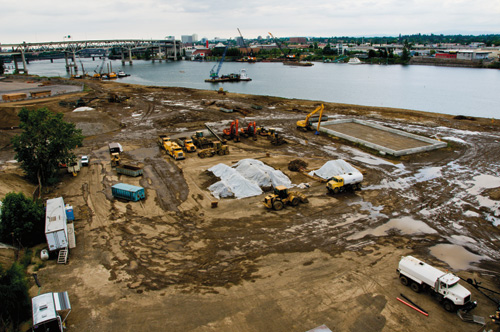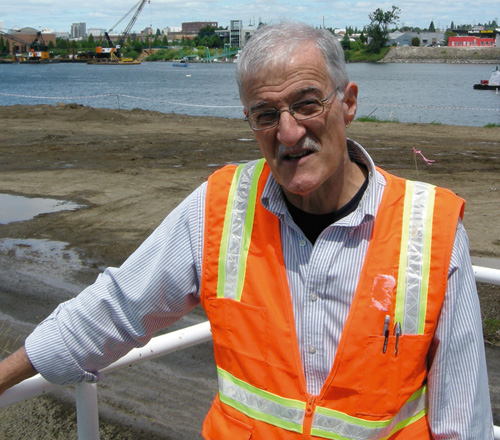 The aptly named environmental consultant Paul Fishman has enjoyed a long career at the intersection of the built environment and the natural world. His biggest projects have involved elaborate cleanups that balance the needs of industrial clients facing regulatory pressure and endangered fish in the Willamette River. None has been larger or more complex than his latest, the long-awaited cleanup of the Zidell property along the river between downtown and South Waterfront.
The aptly named environmental consultant Paul Fishman has enjoyed a long career at the intersection of the built environment and the natural world. His biggest projects have involved elaborate cleanups that balance the needs of industrial clients facing regulatory pressure and endangered fish in the Willamette River. None has been larger or more complex than his latest, the long-awaited cleanup of the Zidell property along the river between downtown and South Waterfront.
By Ben Jacklet
 |
Above: Paul Fishman works on the cleanup of the Zidell property south of downtown. Below: The 30-acre Zidell parcel on the Willamette River is undergoing a $20 million cleanup that will create new development opportunities. // Photos by Teresa Meier |
 |
The aptly named environmental consultant Paul Fishman has enjoyed a long career at the intersection of the built environment and the natural world. His biggest projects have involved elaborate cleanups that balance the needs of industrial clients facing regulatory pressure and endangered fish in the Willamette River. None has been larger or more complex than his latest, the long-awaited cleanup of the Zidell property along the river between downtown and South Waterfront.
“This is probably the largest private cleanup on the Willamette River to date,” he says as he walks from Zidell headquarters toward a shoreline degraded by PCBs, heavy metals and petroleum waste. “It’s huge. What an opportunity.”
The 30-acre parcel, once used to build and later dismantle World War II Navy ships, has sat as mostly vacant rubble for 16 years as the Zidell family negotiated a cleanup agreement with environmental regulators. With that deal approved in February teams of commercial divers, barge operators and asbestos abatement workers are rushing to bury the pollution of the past and set the stage for urban development. The $20 million cleanup coincides with nearby efforts to build a light-rail bridge over the river and a pedestrian bridge over I-5, turning a former dead zone into a hive of activity.
Contractors have removed upland “hot spots” of pollution and are capping the riverbank with sand and rock armor to seal off the contamination, followed by “habitat gravel” for the fish. Landscaping will follow, along with street grids and eventually, the city’s newest neighborhood. The Oregon University System is developing a life sciences research center at an adjacent property owned by OHSU, and plans are being hatched for as many as 20 new mixed-use towers, park blocks, green spaces and a waterfront bike path. The Zidell barge-building facility will remain for a while but will likely be dismantled eventually.
ZRZ Realty, the holding company for the property, plans to develop the area piece by piece, following the market. “This is the next really interesting part of the city to develop,” says ZRZ’s Matt French.
Fishman and Zidell are consulting with environmental officials to make sure the fast-moving cleanup meets the company’s obligations. They expect to finish by November 2012. Then begins the work of building an urban center from scratch, at a time when the city’s real estate market may be recovering — or not.

